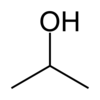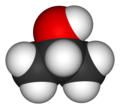异丙醇
| A+医学百科 >> 异丙醇 |
英文品名: iso-Propyl alcohol ;isopropanol;Dimethylcarbinol;2-Propanol俗称IPA
分子式: C3H8O;(CH3)2CHOH
它是正丙醇 CH3-CH2-CH2OH 的同分异构体。
InChI 1/CH4N2O/c2-1(3)4/h(H4,2,3,4)/f/h2-3H2
CAS号67-63-0
RTECS号 NT8050000
目录 |
理化特性
分子量:60.07 g/mol
密度 SpecificGravity: 0.78505(Water=1)
性状:无色透明挥发性液体。有似乙醇和丙酮混合物的气味,其气味不大。其蒸汽能对眼睛、鼻子和咽喉产生轻微刺激;能通过皮肤被人体吸收。
能与水、醇、醚相混溶。
与水能形成共沸物。
它易燃,蒸气与空气形成爆炸性混合物,爆炸极限lower 2.5 vol.% Upper 12.7 vol.%(体积)属于一种中等爆炸危险物品。
其蒸汽能滚动流过相当长的距离,并能产生回火。
蒸气压(Pa):92232(80℃);38463(60℃);1187(0℃)
粘度 2.86 cP at 15 °C ;1.77 cP at 30 °C
粘度 mPa•s(20℃):2.1
沸点BoilingPoint: 82.5°C(180.5°F)
熔点MeltingPoint: -88.5°C(-127.3°F)
临界点CriticalTemperature: 235°C(455°F)
自燃点:425℃
闪点12℃(闭杯)
蒸气密度VaporDensity: 2.07(空气Air=1)
蒸气压VaporPressure: 4.4kPa(@20°C)
分子偶极距 1.66 D 气态
毒性:有毒。
折射率:1.3776
Odor:Pleasant.Odorresemblingthatofamixtureof
ethanolandacetone.
Taste: Bitter.(Slight.)
pH(1%soln/water): Notavailable.
Volatility: Notavailable.
OdorThreshold:22ppm(Sittig,1991)700ppmforunadaptedpanelists(Verschuren,1983).
Water/OilDist.Coeff.: Theproductisequallysolubleinoilandwater;log(oil/water)=0.1
Ionicity(inWater): Notavailable.
DispersionProperties: Seesolubilityinwater,methanol,diethylether,n-octanol,acetone.
mp -88.5℃.bp82.5℃.Fp(闭杯)53℃(.7℉)n20D1.3772。
毒性LD50(mg/kg):大鼠经口5800。
主要用途
重要的化工产品和原料。主要用于制药、化妆品、塑料、香料、涂料及电子工业上用作脱水剂及清洗剂。测定钡、钙、镁、镍、钾、钠和锶等的试剂。色谱分析参比物质。电子工业用。在许多工业和消费产品中,异丙醇用作低成本溶剂,也用作萃取剂。欧洲溶剂工业集团(ESIG)称,2001年欧洲中间体需求占到异丙醇消费量的32%,有14%的异丙醇用作防冰剂,13%用于油漆和树脂,9%用于药物,4%用于食品和3%用于油墨和粘合剂。异丙醇还用作油品和胶体的溶剂,以及用于鱼粉饲料浓缩物的制造中。低品质的异丙醇用在汽车燃料中。 异丙醇作为丙酮生产原料的用量在下降。有几种化合物是用异丙醇合成的,如甲基异丁基酮和许多酯。可根据最终用途供应不同品质的异丙醇。无水异丙醇的常规质量为99%以上,而专用级异丙醇含量在99.8%以上(用于香精和药物)。用于制取丙酮、二异丙醚、乙酸异丙酯和麝香草酚等。在许多情况下可代替乙醇使用。
制备方法
先用 90 ~ 95% 硫酸吸收丙烯 CH3CHCH2( 从热裂石油气分出 ) ,继加水分解异丙基硫酸,再用蒸馏法蒸出异丙醇。或用酸性阳离子树脂和硅钨酸均相催化剂使丙烯水合而得。
包装储运
一级易燃液体。密封保存。150Kg桶包装,应处于阴凉、通风的专用仓库内,远离火源,按易燃化学品规定储运。
材料安全数据表】(中英双语)
MSDS异丙醇
第一部分:化学品名称
化学品中文名称: 2-丙醇
化学品英文名称: 2-propanol
中文名称2: 异丙醇
英文名称2: isopropyl alcohol
技术说明书编码: 149
CAS No.: 67-63-0
分子式: C3H8O
分子量: 60.10
第二部分:成分/组成信息
有害物成分 含量 CAS No.
2-丙醇 67-63-0
第三部分:危险性概述
危险性类别:
侵入途径:
健康危害: 接触高浓度蒸气出现头痛、倦睡、共济失调以及眼、鼻、喉刺激症状。口服可致恶心、呕吐、腹痛、腹泻、倦睡、昏迷甚至死亡。长期皮肤接触可致皮肤干燥、皲裂。
环境危害:
燃爆危险: 本品易燃,具刺激性。
第四部分:急救措施
皮肤接触: 脱去污染的衣着,用肥皂水和清水彻底冲洗皮肤。
眼睛接触: 提起眼睑,用流动清水或生理盐水冲洗。就医。
吸入: 迅速脱离现场至空气新鲜处。保持呼吸道通畅。如呼吸困难,给输氧。如呼吸停止,立即进行人工呼吸。就医。
食入: 饮足量温水,催吐。洗胃。就医。
第五部分:消防措施
危险特性: 易燃,其蒸气与空气可形成爆炸性混合物,遇明火、高热能引起燃烧爆炸。与氧化剂接触猛烈反应。在火场中,受热的容器有爆炸危险。其蒸气比空气重,能在较低处扩散到相当远的地方,遇火源会着火回燃。
灭火方法: 尽可能将容器从火场移至空旷处。喷水保持火场容器冷却,直至灭火结束。处在火场中的容器若已变色或从安全泄压装置中产生声音,必须马上撤离。灭火剂:抗溶性泡沫、干粉、二氧化碳、砂土。
第六部分:泄漏应急处理
应急处理: 迅速撤离泄漏污染区人员至安全区,并进行隔离,严格限制出入。切断火源。建议应急处理人员戴自给正压式呼吸器,穿防静电工作服。尽可能切断泄漏源。防止流入下水道、排洪沟等限制性空间。小量泄漏:用砂土或其它不燃材料吸附或吸收。也可以用大量水冲洗,洗水稀释后放入废水系统。大量泄漏:构筑围堤或挖坑收容。用泡沫覆盖,降低蒸气灾害。用防爆泵转移至槽车或专用收集器内,回收或运至废物处理场所处置。
第七部分:操作处置与储存
操作注意事项: 密闭操作,全面通风。操作人员必须经过专门培训,严格遵守操作规程。建议操作人员佩戴过滤式防毒面具(半面罩),戴安全防护眼镜,穿防静电工作服,戴乳胶手套。远离火种、热源,工作场所严禁吸烟。使用防爆型的通风系统和设备。防止蒸气泄漏到工作场所空气中。避免与氧化剂、酸类、卤素接触。灌装时应控制流速,且有接地装置,防止静电积聚。搬运时要轻装轻卸,防止包装及容器损坏。配备相应品种和数量的消防器材及泄漏应急处理设备。倒空的容器可能残留有害物。
储存注意事项: 储存于阴凉、通风的库房。远离火种、热源。库温不宜超过30℃。保持容器密封。应与氧化剂、酸类、卤素等分开存放,切忌混储。采用防爆型照明、通风设施。禁止使用易产生火花的机械设备和工具。储区应备有泄漏应急处理设备和合适的收容材料。
第八部分:接触控制/个体防护
职业接触限值
中国MAC(mg/m3): 200
前苏联MAC(mg/m3): 10
TLVTN: OSHA 400ppm,985mg/m3; ACGIH 400ppm,983mg/m3
TLVWN: ACGIH 500ppm,1230mg/m3
监测方法:
工程控制: 生产过程密闭,全面通风。提供安全淋浴和洗眼设备。
呼吸系统防护: 一般不需要特殊防护,高浓度接触时可佩戴过滤式防毒面具(半面罩)。
眼睛防护: 一般不需要特殊防护,高浓度接触时可戴安全防护眼镜。
身体防护: 穿防静电工作服。
手防护: 戴乳胶手套。
其他防护: 工作现场严禁吸烟。保持良好的卫生习惯。
第九部分:理化特性
主要成分: 纯品
外观与性状: 无色透明液体,有似乙醇和丙酮混合物的气味。
pH:
熔点(℃): -88.5
沸点(℃): 80.3
相对密度(水=1): 0.79
相对蒸气密度(空气=1): 2.07
饱和蒸气压(kPa): 4.40(20℃)
燃烧热(kJ/mol): 1984.7
临界温度(℃): 275.2
临界压力(MPa): 4.76
辛醇/水分配系数的对数值: <0.28
闪点(℃): 12
引燃温度(℃): 399
爆炸上限%(V/V): 12.7
爆炸下限%(V/V): 2.0
溶解性: 溶于水、醇、醚、苯、氯仿等多数有机溶剂。
主要用途: 是重要的化工产品和原料。主要用于制药、化妆品、塑料、香料、涂料等。
其它理化性质:
第十部分:稳定性和反应活性
稳定性:
禁配物: 强氧化剂、酸类、酸酐、卤素。
避免接触的条件:
聚合危害:
分解产物:
第十一部分:毒理学资料
急性毒性: LD50:5045 mg/kg(大鼠经口);12800 mg/kg(兔经皮)
LC50:无资料
亚急性和慢性毒性:
刺激性:
致敏性:
致突变性:
致畸性:
致癌性:
第十二部分:生态学资料
生态毒理毒性:
生物降解性:
非生物降解性:
生物富集或生物积累性:
其它有害作用: 该物质对环境可能有危害,对水体应给予特别注意。
第十三部分:废弃处置
废弃物性质:
废弃处置方法: 用焚烧法处置。
废弃注意事项:
第十四部分:运输信息
危险货物编号: 32064
UN编号: 1219
包装标志:
包装类别: O52
包装方法: 小开口钢桶;安瓿瓶外普通木箱;螺纹口玻璃瓶、铁盖压口玻璃瓶、塑料瓶或金属桶(罐)外普通木箱;螺纹口玻璃瓶、塑料瓶或镀锡薄钢板桶(罐)外满底板花格箱、纤维板箱或胶合板箱。
运输注意事项: 运输时运输车辆应配备相应品种和数量的消防器材及泄漏应急处理设备。夏季最好早晚运输。运输时所用的槽(罐)车应有接地链,槽内可设孔隔板以减少震荡产生静电。严禁与氧化剂、酸类、卤素、食用化学品等混装混运。运输途中应防曝晒、雨淋,防高温。中途停留时应远离火种、热源、高温区。装运该物品的车辆排气管必须配备阻火装置,禁止使用易产生火花的机械设备和工具装卸。公路运输时要按规定路线行驶,勿在居民区和人口稠密区停留。铁路运输时要禁止溜放。严禁用木船、水泥船散装运输。
第十五部分:法规信息
MSDS简要说明了一种化学品对人类健康和环境的危害性并提供如何安全搬运、贮存和使用该化学品的信息。作为提供给用户的一项服务,生产企业应随化学商品向用户提供安全说明书,使用户明了化学品的有关危害,使用时能主动进行防护,起到减少职业危害和预防化学事故的作用.MSDS可由生产厂家按照相关规则自行编写.MSDS评估认证报告是应产品进口国的法律规定与要求编写的。目前化学品评估编写的法律规定,国际上尚没有统一的标准,一般国际通行的版本是欧盟的EEC/ISO版本,和美国的OSHA及ANSI版本。由于各个国家,甚至各个州的化学品管理及贸易的法律文件不一样,有的每个月都有变动,如果提供的MSDS报告不正确或者信息不完全,将面临法律责任追究。所以目前国外的客户一般都要求其材料供应商,提供经专业的第三方检测机构进行的MSDS材料安全评估认证谱尼报告,防止由于材料供应商自己编写的MSDS报告不符合相关国家的法律规定,或者MSDS报告提供的材料安全数据不符实所造成的安全事故及法律责任。
法规信息 化学危险物品安全管理条例 (1987年2月17日国务院发布),化学危险物品安全管理条例实施细则 (化劳发[1992] 677号),工作场所安全使用化学品规定 ([1996]劳部发423号)等法规,针对化学危险品的安全使用、生产、储存、运输、装卸等方面均作了相应规定;常用危险化学品的分类及标志 (GB 13690-92)将该物质划为第3.2 类中闪点易燃液体。
【MSDS】
HAZARDS IDENTIFICATION
Product Name
PROPAN-2-OL
Proper Shipping Name
ISOPROPANOL (ISOPROPYL ALCOHOL)
Other Names
Name
Grade
Labscan Code:PROPAN-2-OL
AR:A3515
PROPAN-2-OL
HPLC
C2519
PROPAN-2-OL
PESTI
P5515
PROPAN-2-OL
SPECTRO
S7515
ISO-PROPYL ALCOHOL
ISOPROPANOL
2-PROPANOL
SEC-PROPYL ALCOHOL
UN No.:1219
D.G. Class:3.2
Packing Group:II
Hazchem Code:2[Y]E
Poisons schedule:Not schedule
EEC-No: 603-003-00-0
Class: F; R11; Xo R36; R67
CAS-No:67-63-0
Weight
100%
Most Important hazards
Highly flammable, Irritant effect on eyes.
Specific hazards
Liquid causes severe inflammation of conjunctiva and may cause severe damage of the
cornea. Repeated or prolonged exposure may cause skin irritation and dermatitis, due to
degreasing properties of the product. Effects due to ingestion may include: vomiting,
dizziness, abdominal pain & unconsciousness. Effects of breathing high concentrations of
vapor may include; headache, irritation of respiratory system, nausea, vomiting, dizziness &
unconsciousness.
FIRST AID
General advice:
Show this safety data sheet to the doctor in attendance.
Inhalation:
Move to fresh air in case of accidental inhalation of vapors. Keep patient warm. In case of
shortness of breath, give oxygen. Apply artificial respiration only if patient is not breathing or
under medical supervision.
No artificial aspiration mouth-to-mouth or mouth to nose. Use
suitable instruments / apparatus.
Skin contact:
Remove contaminated clothing and wash affected skin with soap and water. If signs of poisoning
appear, treat as for inhalation. Wash contaminated clothing before re-use. Contaminated
combustible material, e.g. clothing ignites more readily and burns fiercely.
Eye contact:
If the substance has got into the eyes, immediately wash out with plenty of water or saline solution
for at least 15 minutes. Obtain medical attention.
Ingestion:
Clean mouth with water and drink afterwards plenty of water. Do not induce vomiting. Keep
patient warm. In case of shortness of breath, give oxygen. Apply artificial respiration only if
patient is not breathing or under medical supervision. No artificial aspiration mouth-to-mouth to
nose. Use suitable instruments / apparatus. Obtain medical attention.
FIRE-FIGHTING MEASURES
Suitable extinguishing media:
Extinguish preferably with dry chemical / alcohol-resistant foam sand.
Extinguishing media which must not be used for safety reasons:
Do not use water jet.
Specific hazards:
Carbon oxides.
Special protective equipment for firefighters:
Wear self-contained breathing apparatus and protective suit.
Specific methods:
Standard procedure for chemical fires. Water mist may be used to cool closed containers.
Hazchem Code:
2 [Y] E
ACCIDENTAL RELEASE MEASURES
Personal precautions:
Evacuate personnel to safe areas. Remove all sources of ignition. Wear self-
contained breathing apparatus and protective suit. Shut off leaks if without risk.
Keep people away from and upwind of spill/leak.
Environmental precautions:
Contain or absorb leaking liquid with sand or earth. Prevent liquid entering
sewers basements and work pits; If substance has entered a water course or
sewer or contaminated soil or vegetation, advise police.
Methods for cleaning up:
Soak up with inert absorbent material (e.g. sand, silica gel, acid binder,
universal binder, sawdust). Transfer to covered steel drums. Contact waste
disposal services. Dispose of promptly.
SAFE HANDLING AND STORAGE INFORMATION
Handling:
Use only in well-ventilated areas. Do not breathe vapors or spray mist. Avoid contact with
skin, eyes and clothing. Take necessary action to avoid static electricity discharge (which
might cause ignition of organic vapors.)
Storage:
Keep tightly closed in a dry, cool and well-ventilated place.
Keep away from heat and sources of ignition. Store in original container.
Electrical equipment should be protected to the appropriate standard.
EXPOSURE CONTROLS / PERSONAL PROTECTION
Chemical Name:
National occupational exposure limits:
ISOPROPYL ALCOHOL
EH40:OES 400 ppm (980 mg/m3) 8h TWA.
EH40:OES 500 PPM (1225 MG/M3)15 min TWA.
Engineering measures to reduce exposure:
The product should only be used in areas from which all naked lights and other sources of ignition have been
excluded. Ventilation hoods and fans required when working with organic solvents or in hot melt applications.
Personal protection equipment:
Respiratory protection:
Incase of insufficient ventilation, wear suitable respiratory equipment.
Hand protection:
PVC or other plastic material gloves.
Eye protection:
Goggles giving complete protection to eyes.
Skin and body protection:
Rubber or plastic boots, Chemical resistant apron / complete suit protecting
against chemicals.
Hygiene measures:
Keep working clothes separately. Keep away from food, drink and animal feeding stuffs.
PHYSICAL DATA AND OTHER PROPERTIES
Formula
(CH3)2CHOH
Form Liquid,
Colour Colourless,
Odour Alcoholic
Boiling point/range
79-82oC
Melting point/range
–88oC
Flash point
12 open cup oC
Autoignition temperature
> 400oC
Flammability limits high flammable
Explosion limits lower 2.5 vol.% Upper 12.7 vol.%
Vapour pressure(20oC)41.6hPa
Relative density(20oC)>= 0.785 <= 0.825
Bulk density 786 kg/m3
Solubility
Water solubility
completely miscible
g/l
Solubility in other solvents
Alcohol & Ether
Viscosity
(20oC)
3.057 (cST)
mPa.s
STABILITY AND REACTIVITY
Stability:
Stable at normal conditions.
No incompatible products to be specially mentioned.
Conditions to avoid:
Stable at normal conditions.
Materials to avoid:
Strong oxidizing agents.
Hazardous decomposition products:
None reasonably for seeable.
TOXICOLOGICAL INFORMATION
Acute toxicity:
Ingestion:
LD50/oral/rat = 5840 mg/kg.
Inhalation:
LD50/inhalation/4h/rat = 46.5 mg/l.
Skin contact:
LD50/dermal/rabbit => 12800 mg/kg.
Sensitization:
Irritant effect on eyes.
Irritant to skin.
Irritating to respiratory system.
Long term toxicity:
Repeated and prolonged exposure may cause skin irritation and dermatitis, due to
degreasing properties of the product.
Chronic toxicity:
No data is available on the product itself.
ECOLOGICAL INFORMATION
Mobility:
Completely miscible with water.
Persistence / degradability:
Readily biodegradable, according to appropriate OECD test
Biochemical oxygen demand (BOD) =>78% theoretical oxygen demand (ThOD)(BOD20)
Bio accumulation:
Bio accumulation not applicable. Bio concentration factor (BCF) = 1
Ecotoxicity:
LC50/96h/fathead minnows = 9600 mg/l.
LC50/24h/daphnia
= > 1000 mg/l.
DISPOSAL CONSIDERATIONS
Waste from residues / unused products:
Can be incinerated, when in compliance with local regulations.
Contact waste disposal services.
Contaminated packaging:
Empty containers can be land filled after cleaning, when in compliance with local regulations.
Continued on next page
PRODUCT NAME : ISO PROPYL ALCOHOL
TRANSPORT INFORMATION
UN-No…………………..…...1219
Marine pollutant…..………not applicable
ADR/RID
Class…………………..……..3.0
Item………………………….3(b)
TREM-CARD………….……..LAB30TR30
HI/UN No……………………33/1219
Proper shipping name…….ISOPROPANOL (Isopropyl alcohol)
IMO
Class………………..………..3.2
EmS…………………………3-06
MFAG………………………...305
IMDG Page…………………3244
Proper shipping name…….ISOPROPANOL (Isopropyl alcohol)
Packaging group………….II
ICAO
Class……………………..…..3.0
UN/ID No……………………1219
Proper shipping name…….ISOPROPANOL (Isopropyl alcohol)
REGULATORY INFORMATION
Classification according to European directive on classification of hazardous preparations 90/492/EEC
Contains:
ISO PROPYL ALCOHOL
Symbol(s):
F – Highly flammable
R – phrase(s)
R11
– Highly flammable.
R36
- Irritating to eyes.
R67
- Vapours may cause drowsiness and dizziness.
S – phrase(s)
S7
- Keep container tightly closed.
S16
- Keep away from sources of ignition – No smoking.
S24/25
- Avoid contact with skin and eyes.
S26
- In case of contact with eyes, rinse immediately with plenty of water and seek
medical advice.
Recommended restrictions:
Take notice of labels and material safety data sheets for the working chemicals.
Take necessary action to avoid static electricity discharge (which might cause
ignition of organic vapors.)
Recommended use:
General purpose solvent.
End of MSDS
|
||||||||||||||||||||||||||||||||
| 关于“异丙醇”的留言: | |
|
目前暂无留言 | |
| 添加留言 | |

